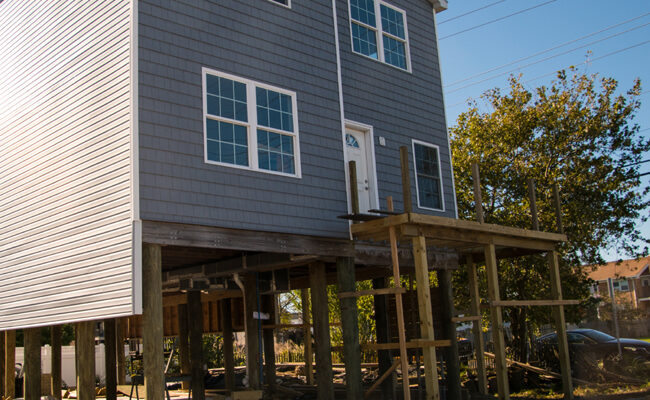
Your home is one of the most important purchases you can make in your life. Not only does it act as a haven for you and your family. It’s also one of your most expensive assets. As such, you’d want to protect it from all kinds of damages. One of the most common problems facing homeowners is the threat of floods due to excessive rainfall, hurricanes, and sudden snow melting.
To safeguard your house from flood damage, there are two options you can consider: house lifting and flood insurance. Here are some of the things you need to know about the cost of lifting vs the cost of homeowners insurance:
The Cost Of Lifting
Lifting a house is a form of repair where your house is elevated to a higher level. In essence, a new foundation is built beneath the old one so that the floor level is considerably above the surrounding ground.
Usually, the overall cost of lifting a house range anywhere between USD$25,000 to USD$100,000, depending on the size of your house. These costs cater to excavation, equipment fees, grading, structural engineer’s fees, and permits from your local building council.
One of the questions you may be asking yourself is, ‘should I lift my house?‘ It all depends on the condition of your current foundation and the degree of the risk of flooding in your area of residence. You normally have three options when it comes to house lifting. These are:
- Building an entirely new foundation: Choose this option if your house’s foundation isn’t very structurally sound.
- Extending the existing foundation: If your house’s foundation is stable but deep-seated, then you can choose to add a base beneath it to elevate it.
- Building an elevated floor inside: If your floor level is flush with the ground level, then all you might have to do is build an elevated floor instead of altering the foundation.
The type of new foundation you choose is quite fundamental in determining your house’s ability to resist flood damage. You’d want a foundation that’ll last for many years. So, choose wisely among the three options above.
By elevating your home, you significantly reduce the risk of flooding. Also, your flood insurance rates won’t be as high as that for a house that hasn’t been lifted. And if your house was built in another historical era, lifting it helps preserve the history of the property.
There are specific factors that may affect the overall cost of lifting a house. These include:
- Size Of The Home: This is the chief determinant of the cost. The larger the house, the more it weighs. Consequently, the more complicated the process of raising and transporting it will be. Most companies, however, charge per square footage. For this reason, you’re expected to pay more for a bigger house.
- Condition/Age Of The House: Older houses were most probably built with heavier materials. Therefore, they require more reinforcement and care than more recently built homes. This means that more time and equipment may be needed to enable the contractors to do an excellent job. Consequently, you need to brace yourself for the total cost of the service.
- Labor: Different contractors have varying rates for house lifting services. You need to do proper market research and hire a company that provides quality services at a reasonable amount. Also, it’d help if you stick to your budget rather than hire very expensive contractors.
- Condition Of The Foundation: If the foundation isn’t structurally sound, it might need repairs to help stabilize the house, and this can significantly add to the total cost.
The Cost Of Insurance For Homeowners

Currently, the average cost of homeowners insurance is USD$1,249 annually. But the cost is likely to go up in the coming years due to inflation. As a first-time homeowner, you may mistakenly believe that the only insurance that you need is homeowners insurance. That’s not entirely true.
A basic homeowner’s insurance only covers items such as:
- Electrical shortages after a storm
- Roof damage through falling branches
- Water damage from small leaks in water pipes
- Damaged or stolen belongings
- Temporary survival costs while your home is being repaired
- Lawsuits if your property causes an accidental injury
- Fire damage
- Wind, hail, and snow damage
- Theft and vandalism
- Lighting
- Power surges
It’s rare for you to get homeowners insurance that also covers flooding. Thus, to safeguard your home from flood damage, you may need to invest in a separate flood insurance policy.
On average, you have to pay about USD$700 annually for flood insurance. The exact amount of your premiums depends on:
- Your location and its weather-related risks.
- The roof type, construction quality, and age of your house.
- Your claims history, available discounts, and insurance score.
Conclusion
To protect your home from the risk of flooding, it’s critical to avail of a flood insurance policy. But you may end up paying a lot of money if the floor of your house sits below the general ground level.
To reduce the premium you pay for flood insurance, you’d want to lift the foundation of your house above the surrounding ground. Interestingly, you can also opt for house lifting alone and do without flood insurance.
Although lifting might be more expensive than getting flood insurance, it might be the more guaranteed approach for safeguarding your home against floods. So, start thinking about lifting your house as soon as possible if it’s in a flood-prone area. Always remember, home is where you should feel more secure and comfortable.
Leave a Reply